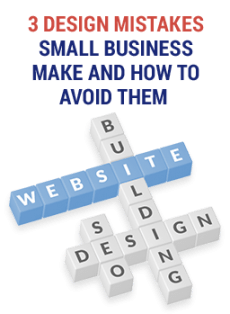
3 Design Mistakes Small Business Make and How to Avoid Them
Most small business owners know that a large percentage of their sales success is driven by the functionality and appearance of their website. Having a website that is not appealing to the eye can cause some consumers to second guess your product, click back and give their business to the competitor. Functionality of a website is of key importance. Consumers prefer a no fuss checkout, easy to find FAQ pages, and believe it or not – sleek, modern designs with quick loading pages. This is most important to e-commerce stores as the website is the only impression consumers have of the brand. You would think twice before entering a clothing store that was visually disorganized with last season’s leftovers- wouldn’t you? Below are a few examples of how you could be hurting your success.
1. Jumbled Pages
Visually appealing presentations are sometimes all it takes to keep consumers interested in your brand. Having an aesthetically pleasing website to view will allow consumers to “make themselves at home” and stay awhile. Too many words on one page can be overwhelming for a consumer. Though the e-commerce store owner may be incredibly passionate about their brand and want to elaborate on details, Cluttered pages look unprofessional. Too much information in one area can become overwhelming and in turn make the consumer feel apprehensive and choose to exit your e-commerce store. Another approach to the overflow of information would be to create secondary pages with a drop down option to neatly organize your information off of the main portion of the webpage.
2. Loud Color Palette
When consumers enter a webpage and the color and contrast is abrasive to the eye they run the other direction. You want them to stick around and learn about your brand and of course, buy something- right? Calm, soothing colors or colors that are well paired are more aesthetically pleasing to the eye. Sharp colors such as neon green and electric orange are not ideal uses of color schematics. Color is one thing, on the other hand you want consumers to be able to easily read your information. You can utilize color and contrast tools to assist you in checking whether or not your page’s contrast is within website color acceptance standards. Keep your color palette to a minimum and let the colors be well paired for a visually pleasing and relaxing read for consumers.
3. Don’t Make Assumptions
If you believe that since you understand how to navigate and use the tools presented on your site that your consumers will too, you are completely wrong. There could be pertinent information, answers to prevalent questions, hiding within the pages of your site and they would never know. Some may happen to stumble upon things like this, but that is not always the case. Consumers want to navigate easily and quickly so they can search, locate their item of interest and close a sale so they can move on to the next need or want. User friendly navigation is a priority if you want your brand and business to be successful and promote repeat customers. To ensure proper navigational function for users, consider the following: use guiding icons, keep related content gathered together, offer a navigational timeline so they know where they are and what to expect when they get to the next phase.
Keeping condensed, relevant material in the same place, using inviting color schemes and proper navigational function will aid your website in a successful direction.
If you would like a free consultation with one of our custom web site development specialists, please contact us today.